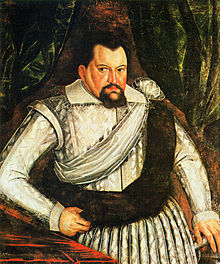This article needs additional citations for verification. (April 2017) |
| John Sigismund | |
|---|---|
 Portrait (unknown artist, c. 1610) | |
| Elector of Brandenburg | |
| Reign | 18 July 1608 – 23 December 1619 |
| Predecessor | Joachim Frederick |
| Successor | George William |
| Duke of Prussia | |
| Reign | 28 August 1618 – 23 December 1619 |
| Predecessor | Albert Frederick |
| Successor | George William |
| Duke of Cleves Count of Mark Count of Ravensburg | |
| Reign | 11 November 1614 – 23 December 1619 |
| Predecessor | John William |
| Successor | Incorporated into Brandenburg |
| Born | 8 November 1572 Halle, Archbishopric of Magdeburg, Holy Roman Empire |
| Died | 23 December 1619 (aged 47) Berlin, Electorate of Brandenburg, Holy Roman Empire |
| Burial | |
| Spouse | |
| Issue more... |
|
| House | Hohenzollern |
| Father | Joachim Frederick, Elector of Brandenburg |
| Mother | Catherine of Brandenburg-Küstrin |
| Religion | Lutheran (until 1613) Calvinist (since 1613) |
| Signature | |
John Sigismund (German: Johann Sigismund; 8 November 1572 – 23 December 1619) was a Prince-elector of the Margraviate of Brandenburg from the House of Hohenzollern. He became the Duke of Prussia through his marriage to Duchess Anna, the eldest daughter of Duke Albert Frederick of Prussia who died without sons. Their marriage resulted in the potential creation of Brandenburg-Prussia, which became a reality after Poland's leader appointed John Sigismund in charge of Prussia in regency and, shortly thereafter, Albert Frederick died without an able, direct male heir.